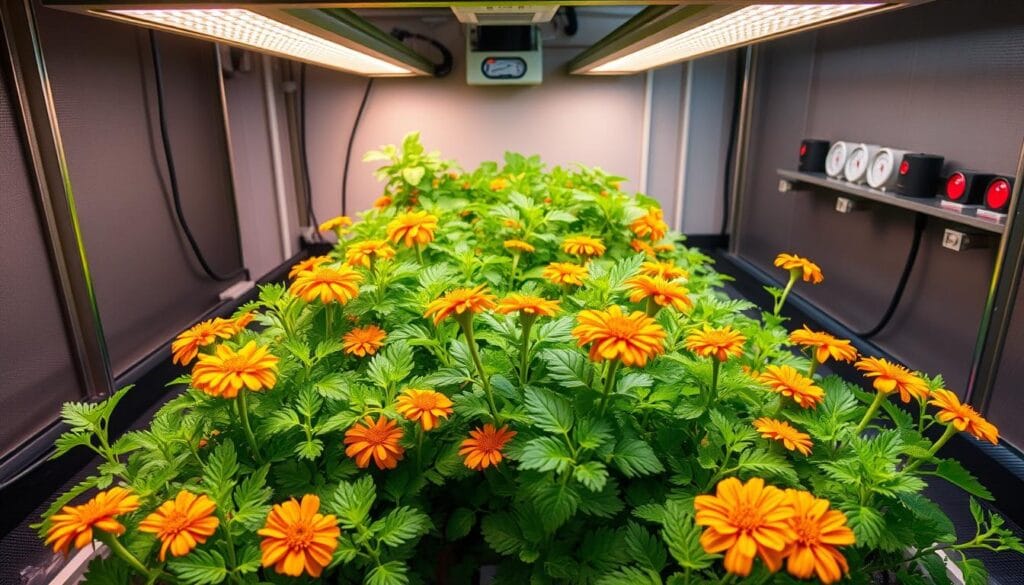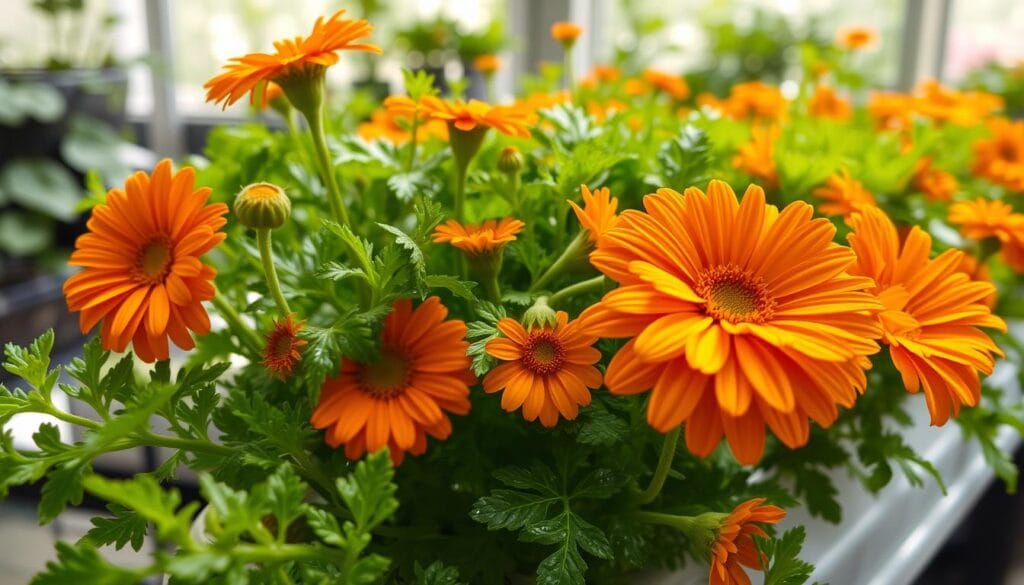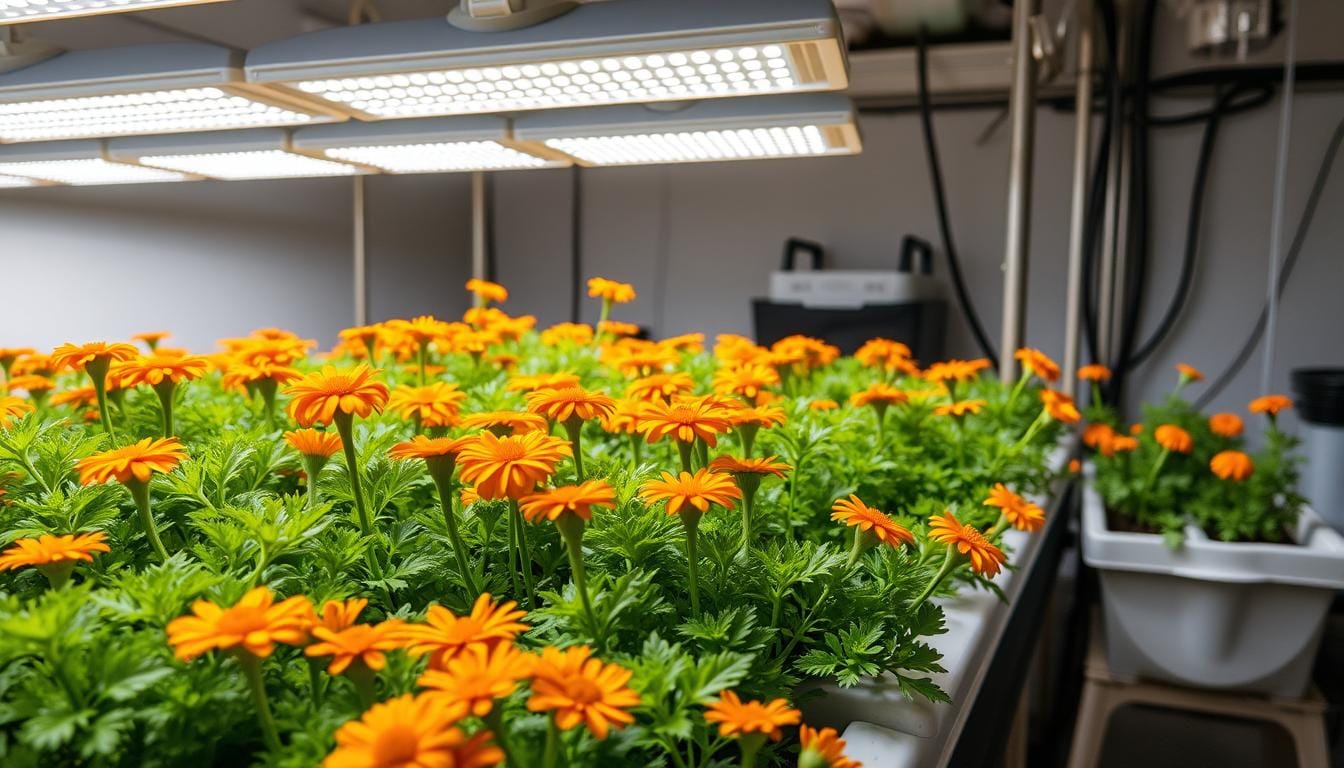Ever dreamed of growing vibrant, medicinal calendula flowers without soil? Hydroponic calendula cultivation is a new world for flower lovers and commercial growers. Your journey into growing calendula for hydroponics starts here, where precision meets botanical beauty.
Calendula, with its radiant orange and yellow blossoms, becomes a hydroponic marvel. These versatile plants thrive in controlled environments. They offer gardeners a chance to grow stunning flowers all year round with innovative hydroponic systems.
Key Takeaways
- Calendula flourishes in various hydroponic setups
- Year-round cultivation is possible with proper techniques
- Precise nutrient management ensures optimal growth
- Hydroponic systems minimize pest and disease risks
- Multiple harvests can be achieved through strategic planning
Understanding Calendula’s Hydroponic Potentials
Hydroponic cultivation is changing how we grow calendula. This new method is efficient and sustainable. It’s great for farmers and gardeners looking to grow plants better.
Benefits of Hydroponic Calendula Cultivation
Growing calendula without soil has many benefits. Hydroponics lets you grow plants faster and get more yields. This is better than growing in soil.
- Accelerated plant growth rates
- Precise nutrient control
- Reduced water consumption
- Minimized pest and disease risks
Key Advantages Of Soil-Based Growing
Hydroponics gives plants a controlled environment. This means they get the right nutrients directly. It’s better than soil for many reasons.
“Hydroponics represents the future of sustainable and efficient crop production” – Agricultural Innovation Journal.
Commercial Growing Opportunities
Hydroponic calendula growing is a big chance for entrepreneurs. The market for edible and medicinal flowers is growing. This means more money for innovative growers.
| Market Segment | Projected Growth |
|---|---|
| Culinary Flowers | 15% Annual Growth |
| Natural Skincare | 22% Annual Growth |
| Herbal Medicine | 18% Annual Growth |
Using hydroponics for calendula puts you at the edge of farming innovation. It also meets the demand for quality, sustainable flowers.
Essential Hydroponic System Requirements
To create a great calendula hydroponic setup, you need to plan well. You must understand the specific growing conditions for these flowers. The right system and environment are key to their success.
When setting up a hydroponic system for calendula, consider a few important things:
- Temperature control (18-24°C during daytime)
- Adequate lighting (12-16 hours daily)
- Well-aerated nutrient solution
- Appropriate space for plant growth
Calendula growing conditions in hydroponics depend on the method you choose. Popular methods include:
- Nutrient Film Technique (NFT)
- Deep Water Culture (DWC)
- Media-based systems
“The key to successful hydroponic calendula is creating an environment that mimics their natural growing preferences while maximizing nutrient delivery.” – Hydroponic Cultivation Expert.
Each method has its benefits for growing calendula. Your choice should match your space, resources, and goals. Remember, calendula plants grow to 10-12 inches tall, so plan your system size.
Choosing the right hydroponic method is the first step to growing healthy calendula. These plants will bloom beautifully with the right care.
Growing Calendula for Hydroponics: Setup and Preparation
Starting your hydroponic calendula setup needs careful planning. You must understand special growing techniques. First, pick the right system and get the necessary materials for your plants to grow well.
Choosing the Right Hydroponic Method
When setting up your hydroponic system, think about different growing methods. The three top methods for growing calendula are:
- Nutrient Film Technique (NFT)
- Deep Water Culture (DWC)
- Media-based systems like Dutch Buckets
System Components and Materials
The success of your hydroponic garden depends on the materials you choose. Key items include:
- High-quality LED grow lights
- Air pumps for root zone oxygenation
- Precision pH and EC meters
- Reliable growing medium
| Growing Medium | Suitability for Calendula |
|---|---|
| Rockwool | Excellent water retention |
| Coco Coir | Superior root support |
| Clay Pebbles | Optimal drainage |
Initial Setup Guidelines
Begin by starting your calendula seeds in a good medium. Move seedlings to the hydroponic system when they have 2-3 true leaves. Hydroponics can produce twice as much as traditional soil gardening, making it very efficient.
Pro tip: Keep the environment consistent to help your calendula grow well.
Using a well-designed hydroponic system lets you control your calendula’s growth. This ensures strong and healthy plants for harvest.
Optimal Environmental Conditions
Growing calendula in hydroponic systems needs careful attention to the environment. Knowing the right temperature, light, and humidity is key to your plant’s health and growth.

Temperature is very important for calendula plants. They do best in a temperature of 18-24°C (64-75°F). At night, the temperature should be a bit lower. This helps mimic outdoor growing conditions.
“Successful hydroponic calendula cultivation is all about creating the perfect microclimate.” – Hydroponic Gardening Expert
Key Environmental Factors
- Keep the light consistent for 12-16 hours a day with full-spectrum lighting
- Use LED grow lights for extra or main light
- Keep humidity between 40-50%
Optimal Growing Conditions
| Environmental Factor | Ideal Range | Impact on Growth |
|---|---|---|
| Temperature | 18-24°C (64-75°F) | Promotes healthy growth and flower production |
| Light Exposure | 12-16 hours | Stimulates photosynthesis and bloom development |
| Humidity | 40-50% | Prevents fungal issues and supports transpiration |
Air circulation is key in your hydroponic setup. Fans help keep the environment steady. This prevents stress on your calendula plants.
Pro tip: Watch your environment closely. Small changes can greatly improve plant health and flower production. Use good monitoring tools to track temperature, humidity, and light.
Nutrient Solution Management
Successful hydroponic calendula cultivation depends on precise nutrient solution management. Your approach to the hydroponic nutrient solution can dramatically impact plant health and flower production.
Understanding calendula nutrient requirements is key for optimal growth. The right balance of nutrients ensures robust plants with vibrant flowers and strong root systems.
Essential Nutrient Ratios
Calendula thrives with a balanced nutrient profile that supports vegetative growth and flowering. Key nutrients include:
- Nitrogen (N): Supports leaf and stem development
- Phosphorus (P): Encourages root growth and flower production
- Potassium (K): Enhances overall plant strength
- Calcium: Improves cell wall structure
- Magnesium: Essential for chlorophyll production
pH and EC Monitoring
Maintaining the correct pH for calendula hydroponics is critical. Aim for a pH range between 6.0 and 7.0, which optimizes nutrient uptake and prevents nutrient lockout.
| Nutrient Parameter | Optimal Range | Impact on Plant Growth |
|---|---|---|
| pH Level | 6.0 – 7.0 | Maximizes nutrient absorption |
| Electrical Conductivity (EC) | 1.2 – 1.8 mS/cm | Indicates nutrient concentration |
Solution Change Schedules
Regular nutrient solution replacement prevents salt buildup and maintains optimal growing conditions. Research indicates that changing your hydroponic nutrient solution every 1-2 weeks supports consistent plant health.
“Precision in nutrient management is the key to exceptional calendula growth in hydroponic systems.” – Hydroponic Experts.
By carefully managing your hydroponic nutrient solution, you’ll create an environment that promotes vigorous calendula growth and abundant flowering.
Light Requirements and Management
Mastering calendula hydroponic lighting is key to success. LED grow lights are essential for the right light for these flowers. Your hydroponic calendula needs careful light management to bloom well.
Understanding light cycles for hydroponic calendula involves several key considerations:
- Provide 12-16 hours of light daily
- Use full-spectrum LED grow lights
- Position lights 12-18 inches above plants
- Implement consistent light timers
“Light is the architect of plant growth, especially for delicate flowers like calendula.” – Hydroponic Gardening Expert.
Calendula grows best with managed light. It’s a short-day plant that needs dark periods to bloom. Your LED grow lights should mimic daylight, giving plants enough energy and rest.
Energy-efficient LED lights with adjustable spectrums can optimize growth stages. Consider these spectrum recommendations:
- Blue spectrum: Encourages vegetative growth
- Red spectrum: Promotes flowering
- Full spectrum: Supports overall plant development
Keep an eye on your plants, adjusting light as they grow. Proper light management leads to healthy calendula plants in your hydroponic system.
Common Pests and Disease Prevention
Hydroponic calendula growing is a controlled way to grow plants. But, it’s important to manage pests to keep plants healthy. Knowing about calendula hydroponic pests and using good prevention methods can help protect your plants.
Identifying Common Pest Issues
Calendula in hydroponic systems can attract pests that harm plants. The main pests of calendula are:
- Aphids: Small insects that cluster on plant stems and leaves
- Caterpillars: Larvae that eat plant tissue, mostly in later growth stages
Prevention Strategies for Disease Control
To prevent diseases in hydroponic calendula, you need to act early. Important steps include:
- Keep the system clean
- Watch humidity levels between 50-60%
- Make sure there’s good airflow
- Use screens to keep pests out
Effective Treatment Methods
If pests show up, try these organic treatments:
- Neem oil: A natural pest repellent
- Bring in beneficial insects for control
- Check plants often for early signs
“Prevention is always better than cure in hydroponic calendula cultivation.”
Always watch your plants closely and act fast if you see pests or diseases. This is the best way to protect your hydroponic calendula system.
Harvesting and Post-Harvest Handling
Timing is key when harvesting hydroponic calendula. Pick the flowers when they’re fully open, in the morning after dew has gone. Use clean, sharp scissors to cut the stems, leaving enough for processing or bouquets.

- Gently rinse harvested flowers with cool water
- Pat dry using a clean, soft towel
- Remove any damaged or discolored petals
- Sort flowers by quality and intended use
Storing calendula flowers is important to keep their quality. Fresh flowers can last up to a week in the fridge in a sealed container with a bit of moisture. For longer storage, try these drying methods:
| Drying Method | Duration | Best Use |
|---|---|---|
| Air Drying | 5-7 days | Teas, herbal preparations |
| Dehydrator | 12-24 hours | Cosmetic products, oils |
| Microwave Drying | 2-3 minutes | Quick preservation |
An herbal medicine expert states that the key to preserving calendula’s potency is through careful harvesting and exact post-harvest handling.
Keep dried calendula in airtight containers, away from sunlight and moisture. With proper care, your hydroponic calendula can stay potent and colorful for months. This makes your harvest very valuable for many uses.
Maximizing Yield and Quality
Successful hydroponic calendula cultivation needs careful planning. You must use precise techniques to boost plant performance and flower production. This will greatly affect your calendula harvest’s yield and quality.
Calendula yield optimization involves several key strategies. Experienced growers know and use these carefully.
Pruning Techniques for Enhanced Growth
Pruning hydroponic calendula needs a gentle hand. Your main goals are:
- Removing spent blooms to redirect plant energy
- Promoting bushier plant structures
- Stimulating continuous flower production
- Preventing disease spread
Growth Optimization Strategies
To improve hydroponic calendula quality, try these targeted approaches:
- Keep environmental conditions consistent
- Regularly check the nutrient solution
- Use amino acid biostimulants for better resilience
- Set up strategic lighting schedules
Amino acids can greatly improve plant functions, leading to better growth and stress resistance.
Quality Control Measures
| Control Aspect | Recommended Action |
|---|---|
| Plant Inspection | Weekly thorough health check |
| Sanitation | Follow strict hydroponic system cleaning rules |
| Harvest Handling | Gently collect with minimal flower damage |
By using these strategies, you can get top-notch hydroponic calendula quality. You’ll also maximize your yield.
Conclusion
Starting with hydroponic calendula growing tips changes how you grow flowers. It lets you manage plants in a new, precise way. This method is faster and gives you more control over your plants.
Exploring calendula cultivation shows the power of water-based growing. You can grow healthy, bright calendula plants with less harm to the environment. Hydroponics lets you control nutrients, light, and conditions for better plant growth.
The future of growing flowers is in new methods like hydroponics. As the world faces challenges like climate change and growing populations, your skills are key. Whether for fun or work, you can grow amazing calendula plants efficiently.
Success in hydroponic gardening means always learning and watching your plants. Each time you grow, you can improve your methods. This is your chance to grow in this exciting field.

